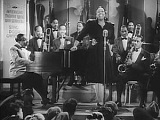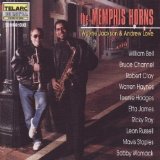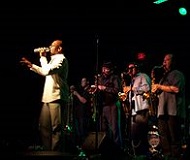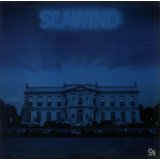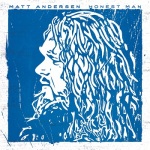 You barely make it past the intro of the album’s opener, “Break Away”, before it hits you; Matt Andersen has a phenomenal voice. It’s a rich baritone from the same mould as the great Paul Carrack and it’s the perfect vehicle for this set of songs harking back to the glory days of Stax and Atlantic. Matt’s previous work has been filed under blues, but there’s no doubt at all that this is a soul album (with a few detours into reggae rhythms and a hint of seventies rock). The album has a lot in common with last year’s Southside Johnny classic “Soultime!” in that they’re both inspired by the glory days of sweet soul music; you can find little references to all sorts of artists and styles throughout the album, but it’s ultimately held together by that superb voice.
You barely make it past the intro of the album’s opener, “Break Away”, before it hits you; Matt Andersen has a phenomenal voice. It’s a rich baritone from the same mould as the great Paul Carrack and it’s the perfect vehicle for this set of songs harking back to the glory days of Stax and Atlantic. Matt’s previous work has been filed under blues, but there’s no doubt at all that this is a soul album (with a few detours into reggae rhythms and a hint of seventies rock). The album has a lot in common with last year’s Southside Johnny classic “Soultime!” in that they’re both inspired by the glory days of sweet soul music; you can find little references to all sorts of artists and styles throughout the album, but it’s ultimately held together by that superb voice.
The album opens with the Hammond-led gentle reggae feel of “Break Away” which hints at “Graceland”-era Paul Simon and The Staples’ “Come Go with Me”, moves into the slow and subtle soul of “The Gift” with its beautiful cascading guitar before the title track throws a whole bunch of influences into the blender. “Honest Man” opens with a riff that’s not a million miles from “Crossroads”, develops with some Memphis Horns-style brass (including the trademark rasping baritone sax) and drops into a chorus with backing vocals which could have been inspired by Don Henley’s scathing “Dirty Laundry”.
So, you get the picture; the album pulls dozens of influences into the blend without ever sounding derivative. “All the Way”, with its hint of a reggae beat, languorous vocal and wah-wah guitar has a hint of seventies Clapton, “Last Surrender” has echoes of Sam Cooke and “Who Are You Listening To?” suggests late seventies Bob Seger, both musically and lyrically. It’s a celebration of some of the classic stylings from our musical history combined with a bunch of well-constructed contemporary songs.
There are a few political and social references, but the songs cover a variety of lyrical themes including love and friendship. “I’m Giving In” is a haunting piano ballad with an intimate, late night vocal while the album’s closer, “One Good Song”, describes the things that a songwriter would suffer to create the one song that makes an audience stop and listen. It’s fair to say that he’s done that a couple of times on this album with the title track and “Last Surrender”. “Honest Man” is a joyous piece of work placing a superb soul voice in settings which demonstrate its quality to perfect effect.
“Honest Man” is released on True North Records (TND612) on April 1st.
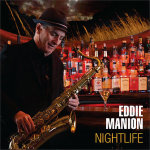 OK, so just to save a bit of time, we all know about Eddie Manion, yeah? Whaddya mean, no? Where have you been for the last forty years? You really should get out more. If you want the whole nine yards, check out his Wikipedia entry, but, just for the moment, his first major gig was with Southside Johnny and the Asbury Jukes, and since then he’s played with Dion, Dave Edmunds, Diana Ross, The Allman Brothers, Willy De Ville, Keith Richards and Bob Dylan and many, many more. He was part of the E Street Band for Bruce Springsteen’s “Wrecking Ball” tour and, more recently, he’s been touring Europe with the Light of Day Foundation raising money for Parkinson’s Disease research. His motto is ‘Have Sax, Will Travel’.
OK, so just to save a bit of time, we all know about Eddie Manion, yeah? Whaddya mean, no? Where have you been for the last forty years? You really should get out more. If you want the whole nine yards, check out his Wikipedia entry, but, just for the moment, his first major gig was with Southside Johnny and the Asbury Jukes, and since then he’s played with Dion, Dave Edmunds, Diana Ross, The Allman Brothers, Willy De Ville, Keith Richards and Bob Dylan and many, many more. He was part of the E Street Band for Bruce Springsteen’s “Wrecking Ball” tour and, more recently, he’s been touring Europe with the Light of Day Foundation raising money for Parkinson’s Disease research. His motto is ‘Have Sax, Will Travel’.
Eddie Manion plays tenor and baritone sax (mainly baritone when working as part of a horn section) as well as having a pretty good voice, which you can hear on his first solo album, “Follow Through”, released in 2004. At the end of the gargantuan “Wrecking Ball” tour, Eddie started work on his second solo album “Nightlife”, opting this time for instrumental interpretations of standards and not-quite-so-standards, rather than his own compositions. It’s a double-edged sword. Both ways you’re going to be judged; one way you’re compared with others’ songwriting, the other way you’re compared with previous versions of the same songs. So how does “Nightlife” shape up?
I guess it’s natural for anyone who’s spent their entire adult life as a professional musician to want to do their own thing once in a while. Eddie Manion’s spent a lot of time playing in horn sections in big bands where nuance isn’t always too high on the agenda, so when the window of opportunity opened, he pulled together a superb bunch of musicians to make an album placing his sax playing firmly stage centre against a backdrop that allows him to interpret songs with style and subtlety. From the album’s opener, a gorgeous version of the theme from the 1961 movie “Town Without Pity”, with its piano triplets and wah-wah trumpet, to the closer “”The Only One, from Roy Orbison’s final album, the album demonstrates Eddie’s ability to create flawless interpretations of jazz standards such as “Smoke Gets in Your Eyes” and “Stardust” whilst also combining Springsteen’s “City of Night” in a medley with King Curtis’s “Soul Serenade”.
Throughout “Nightlife”, Eddie Manion combines a jazz-styled finesse with a rawer rock edge to create a satisfying and varied set of instrumentals that embody great musicianship and sympathetic arrangements. If you value musical skill and the ability to pick a good tune, then you’ll love this; Eddie’s a superb player and he’s surrounded himself with like minds to produce a real musician’s album. As an added bonus, Eddie’s also a very good photographer and the CD packaging includes some of his own fabulous photos taken mainly on the “Wrecking Ball” tour; it’s the icing on the cake of a lovely album.
You can order it here.
Our next contributor plays saxophone with Southside Johnny and The Asbury Jukes but also released a strikingly good album this year as part of the New York Horns which is one of Allan’s albums of the year. When we asked him for a High Fives piece, here’s what he came up with. We think you’ll like this.
5 Horn Sections That Changed My Life
As a saxophone player, one of my absolute favorite ways to make music is with other horn players. Give me a trumpet or two, a couple of other saxophone players and a trombone to add some love, and you’ve got a recipe for a whole lotta fun. If the rhythm section is the meat and potatoes, and the vocalist is dessert, then the horn section is the salt. We bring out all the other flavors and make everything oh so much sweeter.
In thinking about the subject matter for this best-of list, it quickly dawned on me that I had MANY more than five examples that I could draw upon to make my point. So many that I almost gave up! After some careful consideration though, here’s five of the horn sections that have changed my life through their contributions to the music:
THE swingin-est band in the history of jazz. Count Basie’s band emerged in the 1930’s in Kansas City, and became the de facto definition of foot-stomping swing with their penchant for shouting blues, riffing head arrangements, and an infectious groove that just made you want to dance. The jazz traditions of “riffing” and “head arrangements”, while not originating with the Basie band, were certainly developed and forwarded onward by the band. Many of the riffs, licks and phrases that you will hear modern horn sections play can trace some or part of their lineage back to the Basie band. Check out “The Atomic Mr. Basie” (1957) and “Count Basie Swings, Joe Williams Sings” (1956). Two of my all time favorite Basie albums.
James Brown redefined popular music. He also redefined the role of the horn section in popular music. Prior to his influence, horns would generally have a more melodic role – playing melodies and generally being in a “lead” role. The late swing and early jump blues bands often were led by horn players and under the vocals the horns played a large supporting role, remaining a mostly harmonic underpinning. James changed all that. The horn section under James Brown became another rhythmic instrument, driving and propelling the groove. With snapping rhythmic pulses and repeating motifs, the horn section was another texture in the rhythm section, adding propulsion and rhythmic intensity. Check out “Mother Popcorn”, “Super Bad”, “Soul Power” and “Cold Sweat” for classic examples. The JB Horns (Maceo Parker, Fred Wesley, Alfred “Pee Wee” Ellis) also were a fixture of P-Funk and Bootsie’s (Collins) Rubber Band, as the Horny Horns.
Growing up in North Carolina, in the southern United States, it was inevitable that I was exposed to the music coming out of Memphis, Tennessee and especially STAX Records. Wayne Jackson and Andrew Love, aka the Memphis Horns, are one of the most recorded horn sections in history. If you’ve heard “Dock Of The Bay”, “Soul Man”, “Hold On I’m Comin’”, “Suspicious Minds”, “Sweet Caroline”, “Takin’ It To The Streets”, “Let’s Stay Together”, “Born Under A Bad Sign”, “Knock On Wood” (and countless other hits), then you’ve heard the Memphis Horns. They appeared on virtually every STAX recording, backing Otis Redding, Sam & Dave, Eddie Floyd, Carla & Rufus Thomas and an endless list of others. Not only were they a staple of the Memphis scene but could also be found as part of the Muscle Shoals scene, and on recordings with Aretha Franklin and Wilson Pickett.
No modern horn player that plays funk, soul or R&B hasn’t heard of or spent time studying TOP. Bursting onto the scene in Oakland, CA in 1968, Tower saw its peak success from 1973 to 1974. The band continues to tour extensively to this day, playing hundreds of shows every year across the world. The horn section has been featured on countless recordings by artists as diverse as Little Feat, Graham Central Station, The Monkees, Santana, Elton John, John Lee Hooker, Rufus, Rod Stewart, Huey Lewis and the News, and Aerosmith and has come to define a punchy, modern and funky style of writing and performing for horns. Check out “Tower of Power” (1973) and “Back to Oakland” (1974) for the definitive TOP experience.
While not a horn section unto himself, Jerry Hey has probably written more horn arrangements for hit songs and albums than anyone else in the business. As part of the Seawind Horns, Jerry was brought to the attention of Quincy Jones. That relationship led to Jerry’s writing for some of the biggest names in the industry. His credits as an arranger include albums from Michael Jackson, Brothers Johnson, Donna Summer, Rufus, George Benson, Patti Austin, James Ingram, Frank Sinatra, Barbra Streisand, Earth, Wind and Fire , Al Jarreau, Chaka Khan, and the list goes on… Two of my favorite albums that feature Jerry’s writing (and the Jerry Hey Horns) extensively are Al Jarreau’s “Jarreau” and “High Crime” (Check out “Imagination”!) and likely my all time favorite Jerry Hey arrangement (and performance) is from Michael Jackson’s “Workin’ Day And Night” (“Off The Wall”).
I could go on and on… there are so many great horn sections, players and writers out there, making incredible music. Hopefully this list will give you some food for thought and a good place to begin to explore the horn section legacy. Enjoy!


